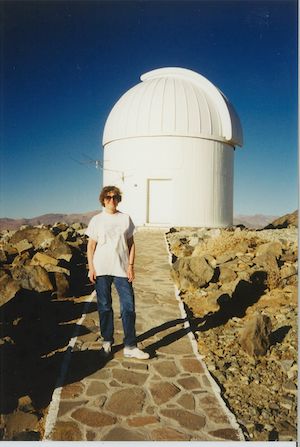CHRISTINE CLEMENT's RESEARCH
with the HELEN SAWYER HOGG TELESCOPE
at LAS CAMPANAS, CHILE
The Helen Sawyer Hogg telescope was a 24-inch Cassegrain reflector set up in Chile in 1971 by the University of Toronto. It was located at the Observatory of the Carnegie Institution of Washington, on Las Campanas, one of the best sites in the world because of its dark, clear skies. The telescope remained in operation until 1997.
In 1972, Helen's globular cluster observing program was transferred to the new telescope and this is where I carried out my research. The southern site was very favourable for observing Milky Way globular clusters because most of them are located in the southern sky. As a result, they can be tracked for long intervals over the course of a single night. This was particularly advantageous for observing RR Lyrae variables which were my main interest. Furthermore, the prime season for observing most globular clusters is from May to July, when the nights are longest, another bonus of observing in the southern hemisphere.
In 1972, at around the time that the southern observatory was getting established, the University of Toronto hosted an international conference to honour Helen for her lifelong contributions to globular cluster and variable star research. It attracted world leaders in the field and provided a valuable forum for discussing suitable observing programs for the new telescope.
In the course of her previous investigations, Helen had discovered a diversity of variable star populations in different clusters. Some had large numbers of variable stars, while others had very few or none at all. The distribution of the periods also varied. Thus, access to a southern site presented an opportunity to extend her surveys to clusters that could not be observed from the north.
However, Martin Schwarzschild, a distinguished astrophysicist from Princeton University, had a different perspective. He said that we already knew about the diversity in the variable star population among different clusters. Consequently, if we wanted to expand our understanding of cluster variable stars to a new level, it would be better to select a few clusters and observe them repeatedly. In those days, this was no mean task because the observations were acquired on photographic plates which are much less efficient than the CCD detectors that are routinely used today. Also, at the time, we did not know what that new level might be.
Nevertheless, in planning my observing programs for Las Campanas, I took Schwarzschild's comments seriously. I selected a few clusters and monitored them each year during my annual Las Campanas observing run. In addition, I spent time surveying other clusters so that I would have new results to publish each year.

Christine Clement at the Helen Sawyer Telescope, University of Toronto Southern Observatory, Las Campanas, Chile.
In the 1980s, astronomers discovered that some RR Lyrae variables pulsated simultaneously in two modes. Identifying which globular clusters had these double-mode RR Lyrae variables and measuring their properties provided a new tool for studying stellar evolution. However, one needed a lot of observations to produce well-defined light curves in order to detect the phenomenon. Thanks to my Las Campanas observations, I immediately became a major player in the field. Then a few years later, Fourier decomposition of light curves was recognized as a valuable technique for analysing RR Lyrae variables. It was shown that properties such as luminosity and metal abundance could be derived from equations relating period and Fourier parameters. Once again, because of my extensive Las Campanas data, I was in a position to make important contributions right away.
In the 1990s, photographic plates became obsolete. They were replaced by CCD detectors which were a great improvement. Because of their greater efficiency, exposure times were much shorter, and with new image processing techniques, magnitudes could be more precisely estimated. Thus well-defined light curves were more readily obtained. As a result, RR Lyrae variables were the focus of many important investigations for distance determinations and for probing galactic structure.
I continued my research at Las Campanas until 1997 when the University of Toronto operation was shut down. After that, I collaborated with groups who obtained observations with telescopes at other sites. I retired in 2006.
